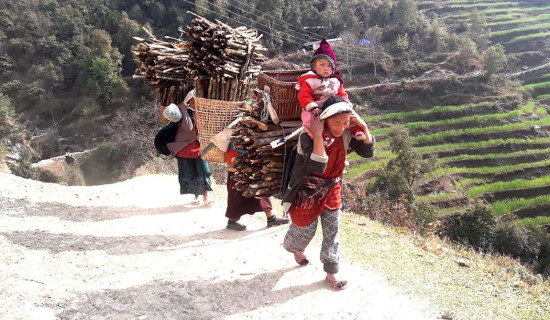- Saturday, 27 December 2025
An Encounter With Tigers In Bardiya
In March of this year, I visited Bardiya National Park and its corridor area to take pictures of tigers in their natural habitat. During the summer, tigers come to drink water and live in water bodies, especially in the national park and Khata Corridor's rivers and ponds due to the heat. I spent 21 days in Bardiya, out of which only 3 days were spent on safari inside Bardiya National Park. I managed to take a picture of a tiger in the national park on one of those days. Afterward, I started looking for tigers in Bardiya's highly vulnerable areas: the Khata corridor area, Madhuvan, and Dalla areas.
The locals of this area are very scared of tigers because they attack and injure people from time to time, and some have even died. In these areas, there are human settlements near the forest and river banks, such as Mukta village, Durga village, Amberpur, Bengalipur, Kharahin village, Sonaha village, Kothia village, Khata, Patthargoji, Madhuvan, Dalla, etc. These areas are near forests and river banks, and some villages are also surrounded by forests. The local residents are suffering a lot from violent animals, and some of them have even died due to tiger attacks. The Khata area is considered a very dangerous area because the Indian border forest is only 1 km away from Khata and the Aurahi River flows through the central part of the Khata community forest. This river is also the area where the tiger roams. Because of this, locals are afraid to walk in this area at night.
Khata Corridor
I consulted with my colleague Theng Chu Tharu of Dalla and started going to the Khata area daily at 11 a.m. to take pictures of the tiger. On the first day of going to Khata's forest, I managed to take a very interesting close-up photo of a tiger that came from the bush in Aurahi River Khata to drink water for about 26 minutes. I hid under the flag so that the tiger wouldn't see me. The forest guard of Khata community forest, forest office staff, and Theng Chu Tharu said that I was the first person to capture a picture of a tiger in this scary forest like this. Otherwise, everyone is afraid to come to this forest. Because this is the forest where the tiger walks.
The next day, I sat on the edge of the forest, waiting to capture the tiger in the Madhuvan 3 forest of the same area. Here too, I managed to capture a tiger. However, on the same day, in the evening, two women were killed by a tiger attack in Madhuvan Ward No. 5. After that, I would constantly go to Khata Forest at 11 a.m. and take pictures of tigers. Most of the time, I saw tigers there. Seeing the roaring of tigers there, I realised that this area is very scary because of tigers. In the lonely forest on the banks of the Aurahi River, there was no one but me, Theng Chu Tharu, and the forest guard.
While tigers are fierce animals, they are also shy. I have experienced this a lot. A tiger was hiding in the water on the bank of the Aurahi River in Khata. Since I could not see the tiger clearly from the forest, I went down from the heights to the river and started taking pictures of the tiger. After a few moments, the tiger heard the clicking of my camera, and as soon as it saw me, it immediately got out of the water and entered the forest thicket. Even in national parks or forests, tigers enter the bush when they see people. Sometimes the question arises as to why this shy animal, the tiger, finally attacks humans.
Within Bardiya National Park, areas where tigers are especially seen are Baghaura, Tented Camp, Lalmati, Balconi, Kathhas, Lamkauli, etc., while sometimes tigers can be seen drinking water in ponds or on roads inside the National Park. Compared to other seasons, tigers are more visible in Flgun, Chaitra, Baisakh, and Jestha due to the heat.
Jocelyn Stokes, a 34-year-old wildlife conservationist and filmmaker from Jackson, Wyoming, USA, visited Bardiya National Park for nine days to shoot tigers. She expressed her happiness at seeing tigers inside the national park every day, and with patience, she managed to capture some great moments of tiger behaviour. Stokes is producing a documentary series about women-led conservation solutions around the world, featuring Doma Paudel in Nepal. Her documentary on tigers in Bardiya National Park will promote Nepal and Bardiya National Wildlife Park around the world. The documentary will be aired soon.
According to Deepak Rajbanshi, a senior nature guide in Bardiya, Stokes' tiger shooting was very successful, and she was lucky to see a tiger every day. Rajbanshi believes that her documentary will attract nature-loving foreign tourists to Nepal. This year, more tigers have been seen in Bardiya National Park than last year, and it is a matter of pride for them.
During her stay in Bardiya, Stokes met the people of the Madhuvan area and Khata area, where local residents go to the Aurahi River to fish, hunt, graze domestic animals, and collect firewood every day. There is an injured tiger in the Madhuvan forest that has hunted many domestic animals for local farmers. Stokes felt that it was necessary to spread public awareness to avoid predatory animals in the area.
Increasing Number
In another part of Bardiya, 55-year-old Bhadai Tharu, nicknamed the "king of tigers," had a close encounter with a tiger while inspecting Gauri Women's Community Forest in Khata. Despite losing his left eye after being hit by the tiger, he managed to save his life by fighting back. Bhadai Tharu now conducts public awareness programmes in the area, promoting the protection of all animals and birds, including tigers. He also commended a foreign photographer for her bravery in taking pictures of tigers in the forest.
The number of tigers in Nepal has increased significantly, from 121 in 2009 to 355 in 2022. There are 41 tigers in Parsa National Park, 128 tigers in Chitwan National Park, 25 tigers in Banke National Park, 125 tigers in Bardiya National Park, and 36 tigers in Shuklaphanta National Park.
In 2010, Russian President Vladimir Putin organised the first-ever Tiger Summit of the world's 13 tiger nations. Nepal had expressed its commitment to double the number of tigers to 250 by 2022 but succeeded in almost tripling the number of tigers in just 12 years. In the same year, the World Tiger Forum decided to celebrate July 29 as World Tiger Day.
The Bengal Tiger (Panthera tigris tigris) is a carnivorous mammal that lives in the forest. It is also the largest and most powerful animal of its species. The spotted tiger can be found in Nepal, India, China, Cambodia, Indonesia, Lao PDR, Malaysia, Myanmar, Russia, Thailand, and Vietnam.
The Bengal tiger has a body colour that is a mixture of golden yellow with black stripes. The colour of its chest and legs is white, while the colour around its eyes and belly is pure white. Adult male tigers weigh between 90 and 306 kg, while females weigh between 65 and 167 kg and range in height from 200 to 275 cm. They can grow up to about 13 feet long. In Nepal, tigers are found in the Terai geo-peripheral region of Chitwan National Park, Parsa National Park, Bardiya National Park, Banke National Park, and Shuklaphanta National Park, with a biological route connecting these protected areas to the Indian border.
The tiger's habitat extends from the moist evergreen, semi-evergreen, deciduous, marshy forests, and grasslands of the Ganges coastal region. The Bengal tiger is found from the beautiful forest at sea level in Bangladesh to the foothills above 4000 m in Bhutan. In Nepal's Terai, after the eradication of malaria in the 1950s, the tiger is now only found in protected habitats due to extensive deforestation caused by migration from the hill region. The tiger's main diet includes sambar deer, chital, wild boar, buffalo, wild deer, gaur, and domestic animals. Tigers have a keen sense of hearing, smell, and sight. They often attack from behind and hunt with great concentration and endurance. Although they can run very fast, they tyre quickly due to their heavy bodies. Tigers usually like to live alone in secluded places and have their own specific territory.
Male and female tigers come together only during the breeding season. After a gestation period of 93 to 112 days, the female tiger gives birth to 2 or 3 cubs. Babies stay with their mothers for about 2.5 years and then roam freely. Tiger cubs learn the art of catching prey from their mothers.
Tigers need relatively large territories and a steady supply of prey to thrive. The average minimum territory size for a female tigress is about 15 to 20 square kilometres. They prefer to live alone in quiet environments and mate only during mating season. An adult male tiger has his own territory, and within that territory live many female tigers. They also have their own small, fixed areas. Male tigers travel several miles in their territory each day and mark their territory by clawing or urinating.
A tiger runs at 65 kilometres per hour and can swim well. The roar of a tiger can be heard up to a distance of about 3 kilometres. Tigers can see six times more than humans at night. As the bones of a tiger are very strong, it can overcome a height of 5 to 8 metres in a single jump. An adult tiger eats about 18 to 40 kg of meat at a time and then does not hunt for about 4 to 5 days. Because tigers drink a lot of water, they live on the banks of ponds and rivers.
Nine Species
There were once nine subspecies of tigers, but currently only six are in existence: the Bengal Tiger, Sumatran Tiger, South China Tiger, Malayan Tiger, Indochina Tiger, and Siberian Tiger. The Caspian tiger (Panthera tigris virgata), Bali tiger (Panthera tigirus balica), and Javan tiger (Panthera tigirus sondaica) have not been found in decades and are considered extinct.
According to Dr. Ganesh Pant, the information officer and ecologist for the National Parks and Wildlife Conservation Department, there are currently 40 adult male tigers and 74 adult female tigers in Bardiya National Park and adjoining forests, with the rest being of unknown sex or tiger cubs. In Nepal, from 2078–079 BS, seven people were moderately injured, eight were seriously injured, and 21 were killed by tigers.
By the end of March 2023, one person had been moderately injured, five had been seriously injured, and nine had died. A total of 6,873,590 relief packages were distributed across the Kingdom of Nepal in 2078–079 BS for minor injuries, severe injuries, and human deaths caused by various wild animals.
Similarly, a total of 33,785,628 relief packages were distributed to people with minor injuries, severe injuries, and deaths up to the middle of April this year.
The IUCN Red List of Tigers indicates that their numbers are in a critical state in all countries where they are found. They have also been placed in Schedule 1 as per the CITES Agreement. According to the National Parks and Wildlife Protection Act of 2029, the tiger is a protected animal. Under Section 26 of the Act (1), anyone who kills or harms a tiger is punishable with a fine of five lakh rupees to ten lakh rupees, imprisonment for five to fifteen years, or both. (All photos were taken at the Khata corridor.)
(Dhungana is a senior wildlife photojournalist and writer.)

















